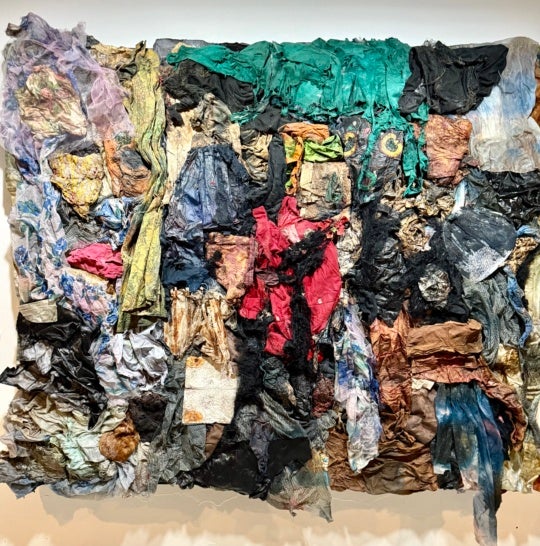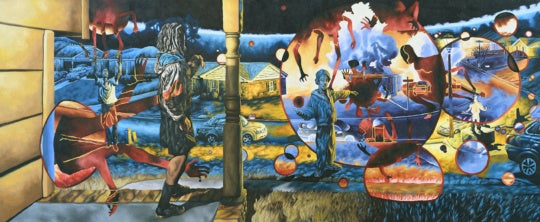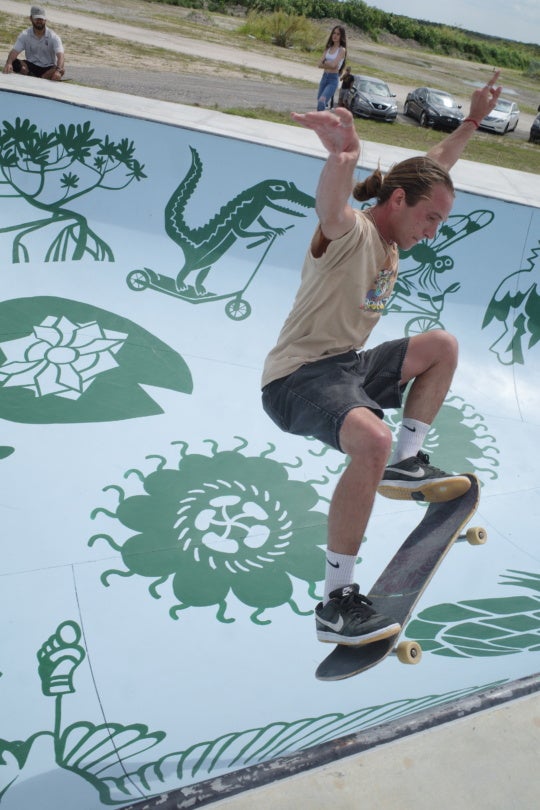
Laura Bell—drawer, painter, printmaker, and professor—deviates from her earlier work with her current exhibition at Whitespace Gallery, Gurgle and Seep [February 22-March 30, 2013]. While Bell explores similar themes in previous work—nature, growth, disruption, and disorder—her current use of stitching, embroidery, and three-dimensional forms has caused her organic shapes to multiply and grow in new ways. Gurgle and Seep introduces an element of tactility that was only alluded to in her previous artwork. Bulbous forms protrude into the viewer’s space and intricate sewn patterns recall the delicate and complex forms found in nature.
Although Bell uses new mediums in Gurgle and Seep, her process is the same—building and adding upon shapes to illustrate repetition and growth. She draws inspiration from slime molds, biological systems, and other organisms and processes found in nature, but her work does not represent them. Instead, Bell’s work references these forms and processes to illustrate the beauty and unpredictability of nature, the effects of change, and the causal relationship between order and disorder.
Bell graciously answered a few questions about her work included in Gurgle and Seep.
Yves Jeffcoat: The title of your exhibition, Gurgle and Seep, seems like an aural representation of the organic, biomorphic shapes that appear in your pieces. The inclusion of the three-dimensional elements in these works has a synesthesia-inducing effect. How have you hoped the introduction of these forms will affect the viewers’ sensory experience?
Laura Bell: Yes, it could certainly be a representation of the sound and activity of the forms that I am working with in this body of work. In the cut paper pieces, the sewn objects, the embroidery, and the clay forms on the paintings and fabric, I am particularly interested in the ways the pieces suggest little active worlds and intrude on or encroach on the viewer’s own space.

YJ: What sparked the decision to use sculptural elements in your work?
LB: I have been interested for some time in incorporating 3-d elements in my work and the surfaces of my prints and paintings have long had subtle raised textures. In the prints, the texture came from the slightly embossed lines and in the paintings, from medium that I used to build up the surfaces. However, the inclusion of the embroidery, sewn objects, clay forms, and layered cut paper, has allowed me to really bring the pieces into physical space, where the viewer interacts with them more directly—although they remain, for the most part, hung on the wall.
YJ: How does the repetitive, mechanical process of stitching compare to the more fluid act of painting and drawing? What details did you include in this series that you could not with previous two-dimensional work?
LB: My work has long had a repetitive, mechanical component to it, and the stitching seemed to naturally grow out of the working process I used in my drawings, paintings and prints. The actual work feels surprisingly similar, in that the fabric is stained and painted; the sewing, cutting and adding happens afterward, partially in response to the fabric. The shadows created on the wall, the tangles of thread that dangle down, the holes and the protrusions create a level of tactility that imply an active and hidden world.
YJ: In your earlier work, you drew inspiration from biological systems, computer generated fractals, lace patterns, and celestial objects. In this exhibition, your work references the human body and the form and function of other living organisms. What similarities have you noticed between natural and artificial processes how is this reflected in your work?
LB: There are repeating forms and patterns that occur in both. The slow enlargement of a shape as it radiates outward, the recurrence of particular elements, or the ways that disruptions can become built in to the structure and affect growth and behavior, are all things that I am interested in addressing. In this work, I am using the element of multiples to create my pieces. As I repeat the object, it begins to mutate with each new version, and the work slowly builds as I combine them.

YJ: In Percolate, the thread seems to pour out of the bulbous growths, and in Source concentric circles emanate from a focal point. Although these depictions recall processes in living organisms, the juxtaposition of science and structure with chaos and imperfection seems to have a more abstract meaning. What is the significance of this ambiguity?
LB: My goal is not one of ambiguity, but I am also not interested in literal depictions or narrative either. The works are my way of contemplating the inevitability of change and my preoccupation with its effects, as I reflect on getting older, as well as my worries for the future of my daughter and the world she is inheriting, one of wonder and beauty certainly, but also one where beloved animals go extinct, viruses grow stronger and more deadly, and weather patterns are violent and unpredictable. This anxiety is built into the work. The pieces contain a world in which a battle between chaos and control is being waged.
YJ: How has using a wider range of mediums allowed you to further explore the ideas of transformation and disruption? How has sewing affected pattern and order in your work?
LB: If anything, sewing has caused the forms to be less orderly. Instead, particular forms repeat in each image, with degrees of variation, but these are not necessarily arranged in an orderly fashion.
YJ: The pieces in Gurgle and Seep recall the patterns found in viruses, plants, diseases, cells, and bacteria. How does this dichotomy of creation and destruction relate to the concept of unexpected beauty that is evident in your artwork?
LB: In this body of work, I am reflecting on our own human inclination to try and impose order both in our own lives, as well as on natural systems around us. I believe disruption and change are a positive aspect of life. We are kept in check and reminded that life is in a state of flux, there are no constants, nothing is permanent, and our actions have repercussions that are often outside of our control. Nature reacts, often in violent and disturbing ways, to our attempts to curb and control it.




